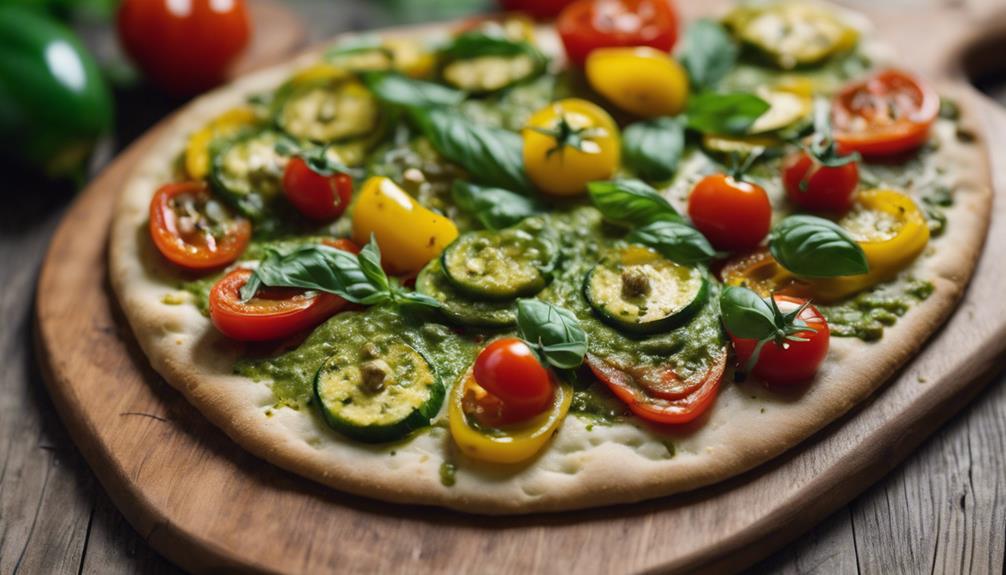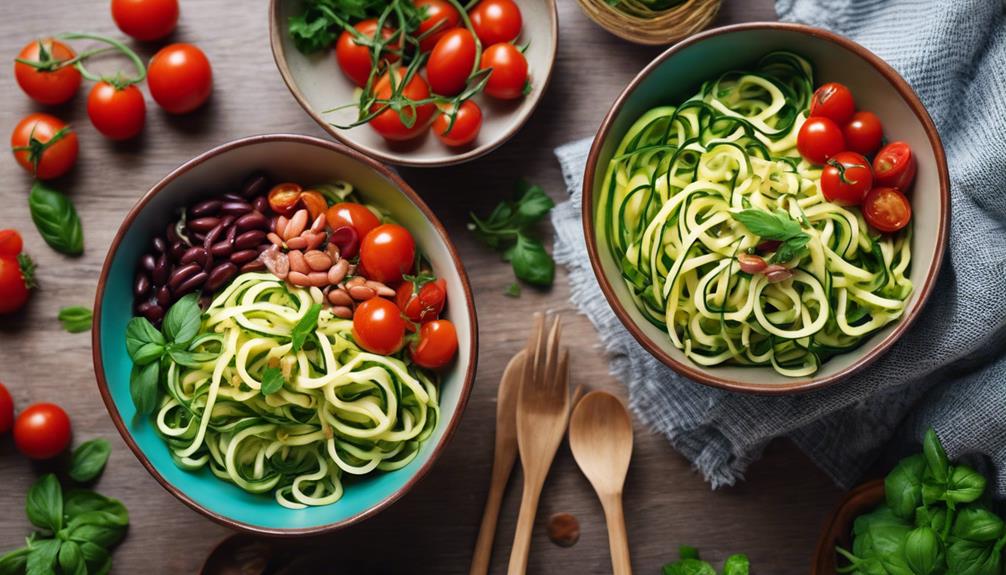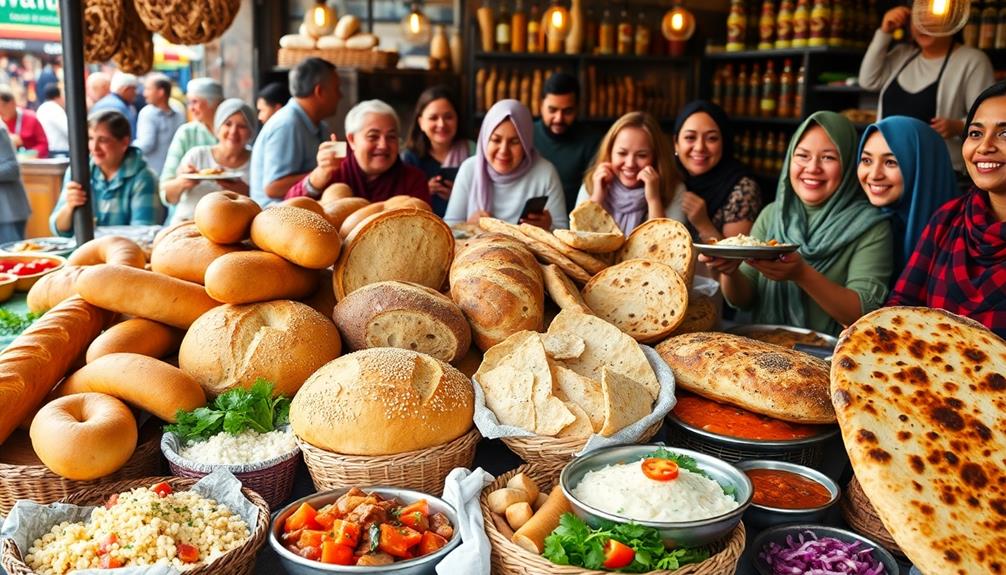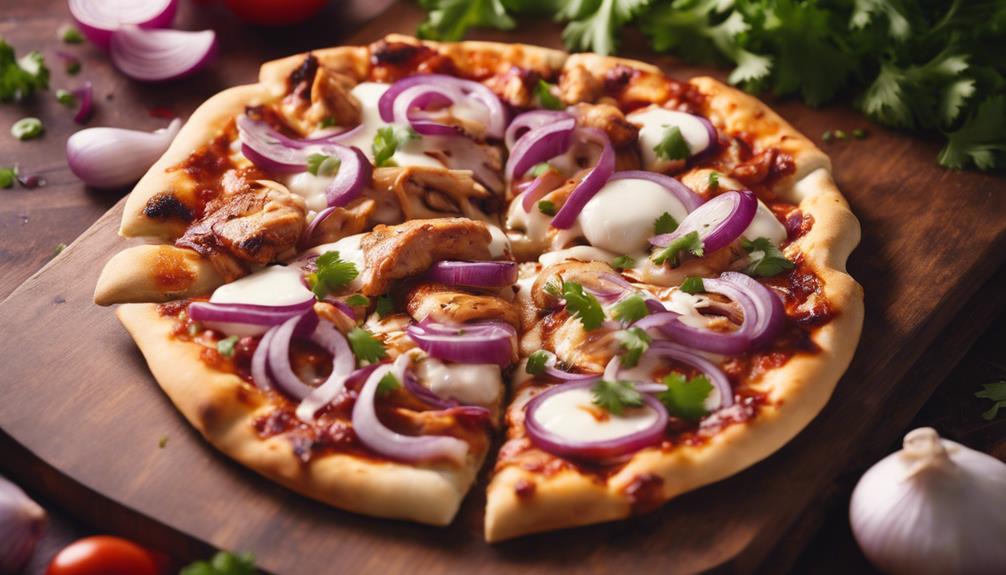To make delicious Cheesy Pesto Veggie Flatbreads, you will need flatbread, basil pesto, mozzarella, cherry tomatoes, and bell peppers. Preheat your oven to 450°F. Spread the pesto on the flatbread, then add layers of mozzarella, tomatoes, and peppers. Bake until golden brown for a crispy crust. For best results, use high-quality pesto such as Buitoni’s or homemade for a special touch. Choose colorful veggies like zucchini and red onions for a burst of freshness. Elevate the flavor by including toppings like artichokes or olives. Enjoy with Sauvignon Blanc or Pinot Grigio for a delicious meal. For a complete dining experience, pair with an Italian chopped salad or dessert like tiramisu.
Key Takeaways
- Use high-quality pesto and fresh veggies for vibrant flavors.
- Opt for low-moisture mozzarella for a perfect melt.
- Experiment with toppings like olives or artichokes for variety.
- Preheat oven to 450°F for a crispy crust.
- Pair with wine or a salad for a complete meal experience.
Ingredients for Cheesy Pesto Veggie Flatbreads
To make Cheesy Pesto Veggie Flatbreads, you'll need flatbread, basil pesto, fresh mozzarella cheese, and a selection of veggies such as cherry tomatoes and bell peppers. These ingredients come together to form a delightful twist on traditional flatbread pizza.
The star of the show, mozzarella cheese, provides a gooey and creamy texture that perfectly complements the vibrant flavors of the pesto and veggies. The flatbread serves as a sturdy base, holding all the delicious toppings in place while crisping up nicely in the oven.
Customization is key when it comes to flatbread pizzas, and Cheesy Pesto Veggie Flatbreads are no exception. Feel free to add your favorite toppings such as olives, mushrooms, or artichokes to elevate the flavors and suit your personal preferences.
The versatility of this dish makes it a quick and easy option for a delicious meal, whether served as a main course or cut into smaller pieces for a delightful appetizer.
Step-by-Step Instructions for Preparation
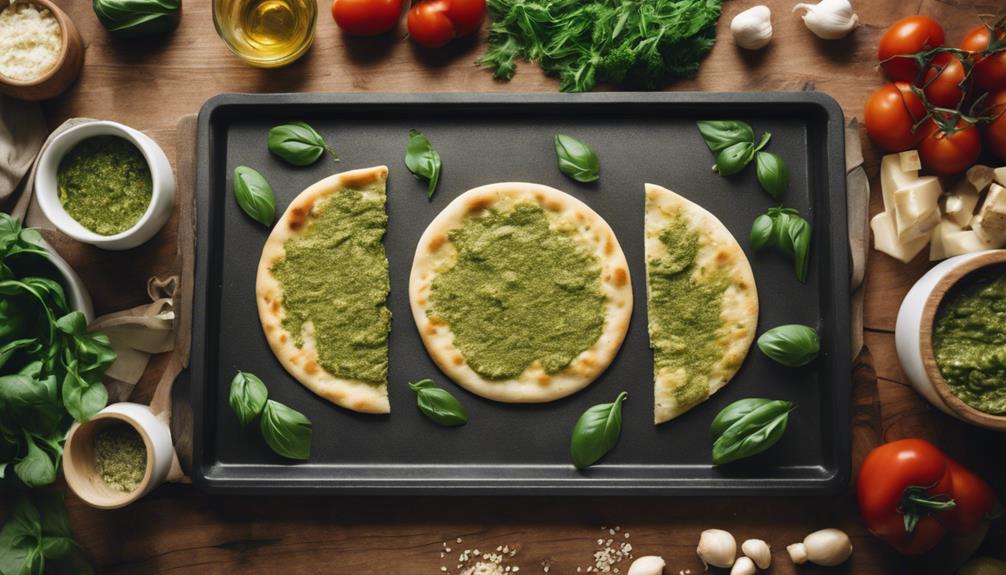
When preparing the Cheesy Pesto Veggie Flatbreads, remember to follow ingredient preparation tips and baking and serving instructions closely. These essential points will guarantee that your flatbreads turn out delicious and perfectly cooked.
Ingredient Preparation Tips
Preheat your oven to 450 degrees before assembling the pesto flatbreads to make certain it's ready for baking.
To prepare the ingredients for your cheesy pesto veggie flatbreads, start by selecting fresh mozzarella cheese for a creamy and melty texture.
Halve cherry tomatoes to add a burst of sweetness and color to each bite of the flatbreads.
Spread a generous amount of prepared pesto on the flatbread to infuse it with flavor before adding toppings.
When assembling the flatbreads, make sure to place them on a baking sheet to prevent any toppings from falling off during baking.
Bake the flatbreads on the baking sheet for 12-15 minutes until the crust is golden brown and the cheese is bubbly.
Following these ingredient preparation tips will help you create a delicious and easy meal that's sure to be a hit with your family or guests.
Baking and Serving Instructions
Make sure the oven is preheated to 450 degrees F for even baking and crispy flatbreads.
To start the baking process, spread a generous amount of pesto on each flatbread, ensuring an infusion of rich, herby flavors.
Next, top the pesto with a layer of fresh mozzarella cheese, allowing for a gooey, melty texture that beautifully complements the veggies.
Arrange cherry tomato halves on the flatbreads for bursts of sweetness and vibrant color.
Place the assembled flatbreads on a baking sheet, making sure they're evenly spaced.
Bake in the preheated oven for 12-15 minutes, or until the crust is a golden brown hue, and the cheese is delightfully bubbly.
Keep a close eye during the last few minutes of baking to prevent any burning.
Once ready, remove the flatbreads from the oven and let them cool slightly before slicing and serving.
Enjoy the delicious blend of flavors and textures in these Cheesy Pesto Veggie Flatbreads.
Choosing the Perfect Pesto Sauce

Consider selecting the perfect pesto sauce to enhance the flavors of your cheesy pesto veggie flatbreads. Store-bought pesto, such as Buitoni's Pesto, comes highly recommended for its homemade taste and quality by America's Test Kitchen. Opting for a pre-made pesto like Buitoni's can offer both convenience and exceptional flavor to your flatbreads.
If customization is your preference, making pesto from scratch is a viable option for those seeking a personalized flatbread experience. Utilizing prepared pesto shortcuts can streamline the process of creating delicious pesto flatbreads without compromising on taste.
Investing in a high-quality pesto, such as Buitoni's, can significantly enhance the flavor profile of your cheesy pesto veggie flatbreads, ensuring a delectable culinary experience. Whether you choose a store-bought option for convenience or decide to craft your pesto from scratch for a tailored touch, the key is to select a pesto sauce that aligns with your taste preferences and enhances the overall enjoyment of your flatbreads.
Selecting Fresh and Flavorful Vegetables
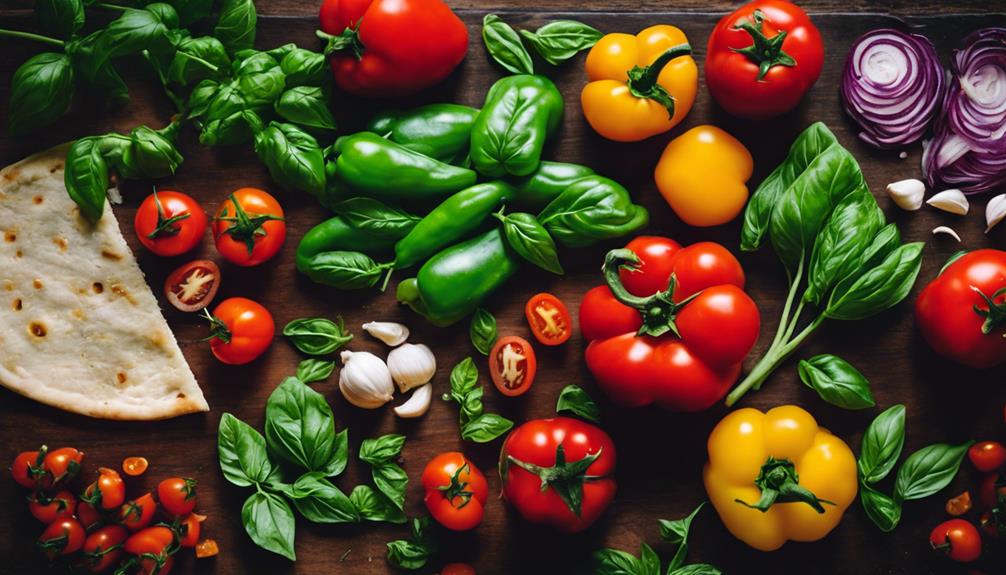
To complement your cheesy pesto veggie flatbreads, start by selecting fresh and flavorful vegetables like bell peppers, cherry tomatoes, zucchini, and red onions for a vibrant and delicious meal.
Opt for organic or locally sourced veggies to guarantee the highest quality and freshness in your dish.
For added depth of flavor, consider experimenting with roasting or grilling the vegetables before adding them to the flatbread. This technique enhances the taste profile, providing a delightful smoky essence to your meal.
To elevate the dish further, incorporate a variety of textures and flavors by including vegetables such as mushrooms, artichokes, and olives.
Additionally, adding leafy greens like spinach, arugula, or kale not only enhances the nutritional value of your flatbread but also introduces a burst of color and freshness.
Enhance the final touch by sprinkling some grated Parmesan and red pepper flakes for an extra kick of flavor.
Tips for Achieving the Perfect Flatbread Crust
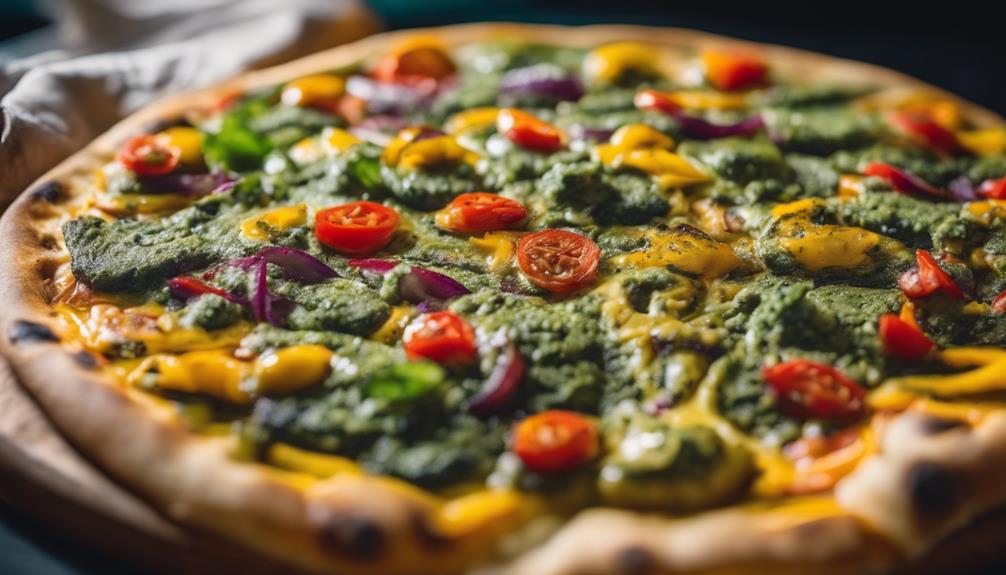
For achieving the perfect flatbread crust, preheat the oven to 450 degrees for best crispiness. This high temperature helps to create a crispy base that complements the toppings.
Consider placing the flatbread directly on the oven rack instead of a baking sheet to allow for better air circulation, resulting in a crispier crust.
When it comes to the cheese, opt for low-moisture fresh mozzarella or shredded mozzarella for a delicious melt and enhanced flavor profile. These cheeses work well with the pesto and other toppings, creating a harmonious blend of textures and tastes.
To achieve a golden brown crust, make sure that your oven is fully preheated before placing the flatbread inside. Experimenting with additional toppings such as artichokes, black olives, or arugula can further elevate the flavors of your flatbread, adding depth and variety to each bite.
Layering the Pesto and Cheese
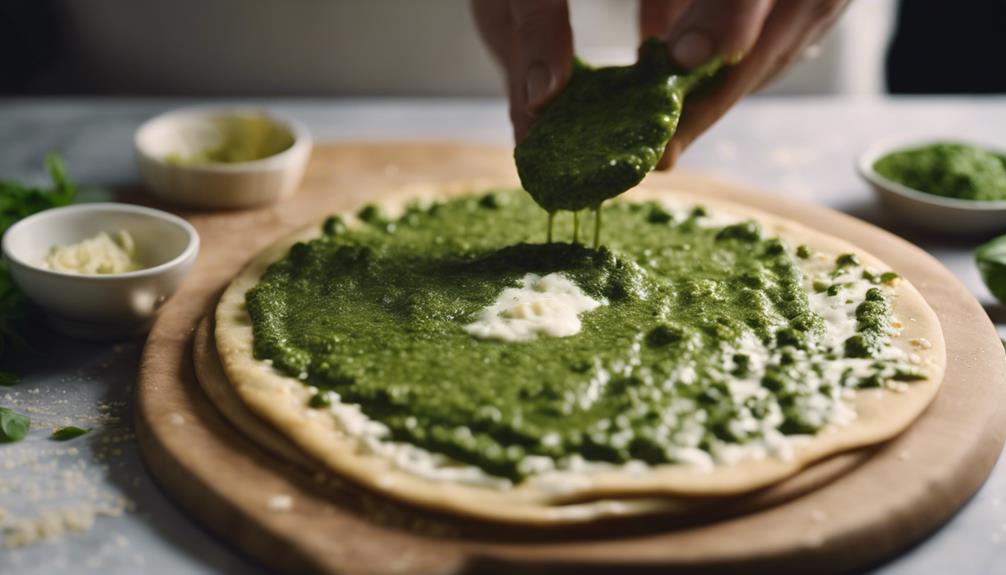
Begin by generously spreading a layer of pesto on the flatbread to establish a flavorful foundation for the toppings. The pesto serves as a zesty and aromatic base that complements the other ingredients.
Next, distribute fresh mozzarella cheese evenly over the pesto. The creamy texture of the mozzarella melts beautifully, creating a rich and gooey layer that enhances the overall taste of the flatbread.
The combination of pesto and cheese intermingles to deliver a savory flavor profile that's both satisfying and delicious. Ensuring an even spread of pesto and cheese is essential to guarantee that each bite is bursting with flavor.
As the flatbread bakes, the cheese melts, blending with the pesto and other toppings to form a cohesive and delectable dish. This meticulous layering process allows the cheese to integrate seamlessly with the pesto, resulting in a mouthwatering culinary experience.
Adding the Colorful Cherry Tomatoes
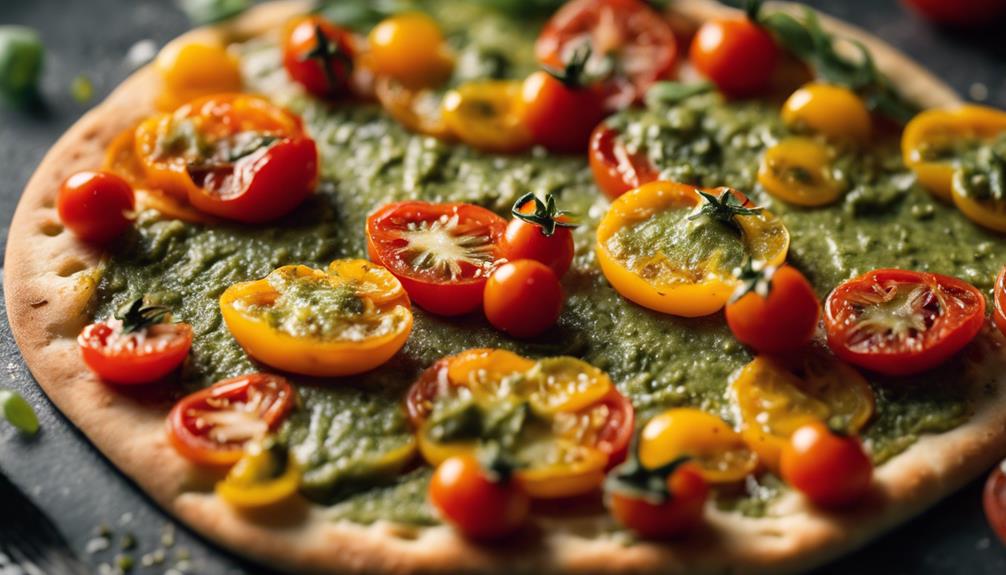
When it comes to selecting cherry tomatoes for your flatbreads, opt for ripe ones that are firm to the touch with a deep red hue.
Halving the cherry tomatoes before adding them to your flatbreads guarantees that their juices meld perfectly with the other ingredients, creating a burst of flavor in every bite.
Tomato Selection Tips
Selecting the perfect cherry tomatoes for your Cheesy Pesto Veggie Flatbreads is crucial for both taste and presentation. When choosing cherry tomatoes, opt for ones that are ripe, firm, brightly colored, and free from blemishes.
These small, sweet tomatoes burst with flavor, making them a colorful and tasty addition to your flatbreads. The visual appeal of cherry tomatoes in various colors like red, yellow, and orange adds a pop of freshness to your dish.
Not only do cherry tomatoes bring a burst of acidity, but they also provide a juicy contrast to the cheesy and savory components of the flatbreads. To enhance the overall flavor profile, consider halving the cherry tomatoes before adding them to your flatbreads.
This technique helps release their juices, further intensifying the flavors in every bite. Making the right choice when selecting cherry tomatoes will surely elevate the taste and aesthetics of your Cheesy Pesto Veggie Flatbreads.
Cherry Tomato Halving
To enhance the visual appeal and flavor profile of your Cheesy Pesto Veggie Flatbreads, consider halving the colorful cherry tomatoes before adding them. By taking this simple step, you not only introduce a burst of color but also infuse a sweet and juicy element into your flatbreads. Cherry tomatoes, known for their antioxidant content, particularly lycopene, can offer potential health benefits while elevating the taste of your dish.
Cutting the cherry tomatoes in half serves a dual purpose. It not only releases their flavorful juices, intensifying their taste but also creates a striking visual contrast against the green pesto, white cheese, and flatbread base. The vibrant red hue of the halved cherry tomatoes adds a pop of color that makes your flatbreads visually appealing and appetizing.
The juicy texture of the tomatoes complements the melted cheese and pesto, creating a delightful combination of flavors and textures in every bite. So, don't forget to halve those cherry tomatoes for a truly delicious flatbread experience.
Baking and Serving Your Flatbreads
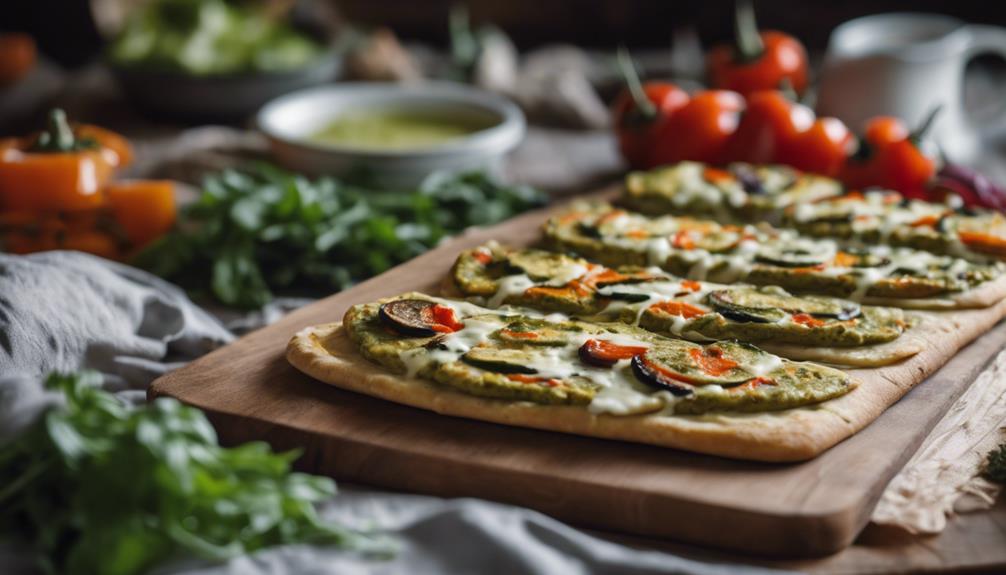
Preheat your oven to 450 degrees Fahrenheit before baking the flatbreads for optimal cooking results.
Using a baking sheet, place the flatbreads in the oven to guarantee even heat distribution for a crispy crust. Consider checking the flatbreads after 12-15 minutes of baking to see if the crust is golden brown and the cheese has melted to perfection.
For a crispier crust, you can choose to bake the flatbreads directly on the oven rack with a sheet positioned below to catch any drippings.
Once the flatbreads are baked to perfection, it's time to slice and serve your cheesy pesto veggie flatbreads. Enjoy the delightful combination of flavors and textures in this simple meal that will surely satisfy your taste buds.
Customizing Your Flatbreads With Additional Toppings
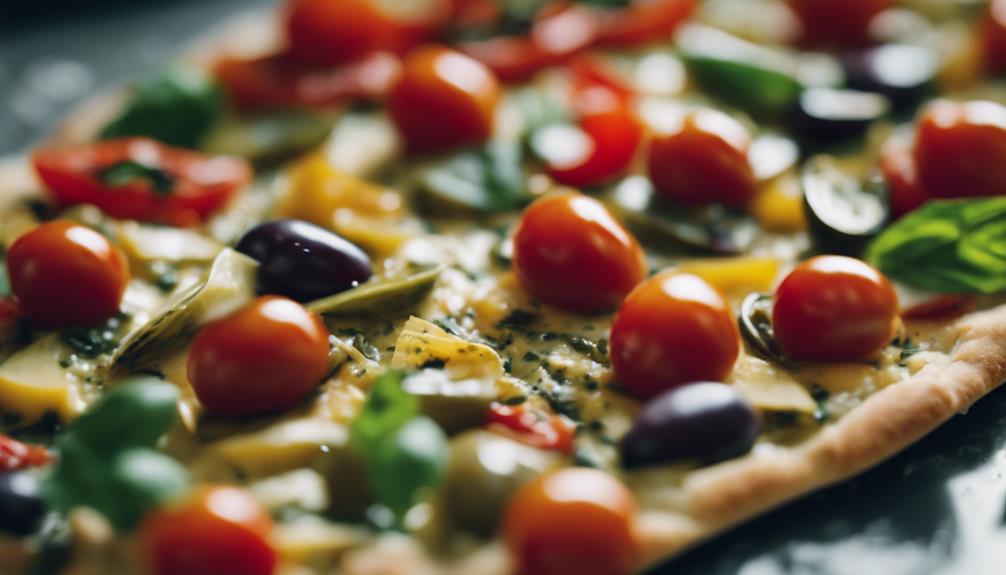
Consider spicing up your cheesy pesto veggie flatbreads by adding sliced black olives for a briny kick. The addition of black olives not only brings a unique flavor to your flatbreads but also offers a satisfying contrast to the creamy pesto and gooey cheese.
Experiment with different cheeses like freshly grated Parmesan or Pecorino Romano to create a diverse palate of tastes that complement the pesto base. For those who enjoy a touch of heat, sprinkle some crushed red pepper flakes over the top for an extra kick of spiciness.
In addition to black olives, customize your flatbreads further by incorporating ingredients such as artichokes, sun-dried tomatoes, or arugula to elevate the depth of flavors. For a burst of color and taste, consider using cherry tomatoes or thinly sliced red onions as vibrant toppings that add a fresh element to your flatbreads.
These additional toppings not only enhance the visual appeal of your dish but also contribute to a more complex and satisfying culinary experience.
Pairing Suggestions for a Complete Meal
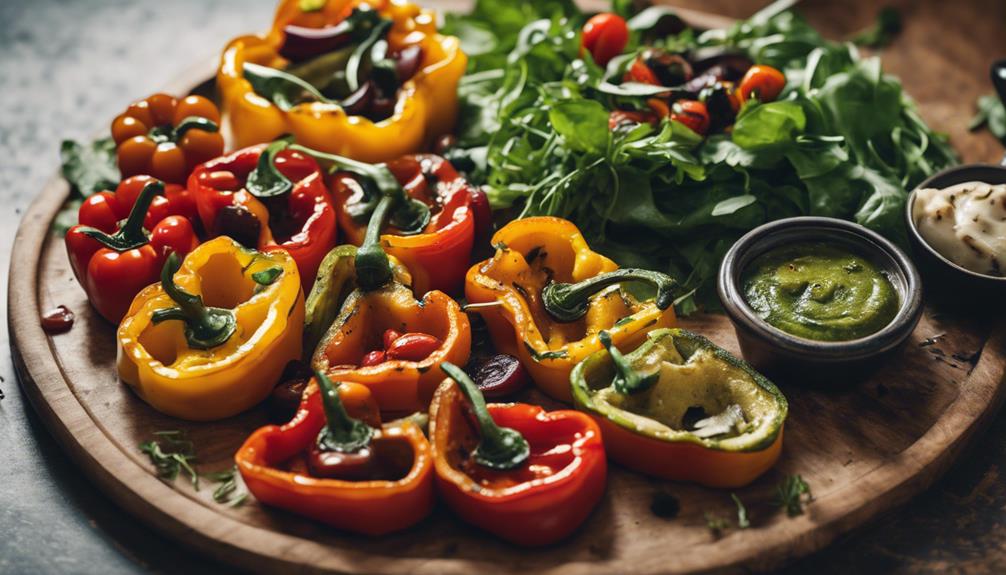
When planning a complete meal to pair with your cheesy pesto veggie flatbreads, consider the ideal drink pairings, side dish ideas, and dessert options.
These elements can elevate your dining experience and create a well-rounded meal that satisfies your palate. From invigorating beverages to delectable sweets, choosing complementary items can enhance the flavors and enjoyment of your flatbreads.
Perfect Drink Pairings
Elevate your dining experience with the cheesy pesto veggie flatbreads by pairing them with a selection of complementary beverages. For a delightful contrast to the rich flavors of the pesto, consider opting for a crisp and invigorating white wine such as Sauvignon Blanc or Pinot Grigio.
If you prefer a non-alcoholic option, a citrusy sparkling water or a fruity iced tea can perfectly complement the herbal notes of the pesto.
Beer enthusiasts may enjoy a light and citrusy wheat beer or a hoppy IPA to enhance the savory and cheesy elements of the flatbreads.
To add a touch of zest and sweetness, classic Italian sodas like Limonata or Aranciata can be a great choice to balance out the richness of the flatbreads.
Offering a variety of beverages, including sparkling wine, craft beer, iced tea, and flavored sodas, ensures a well-rounded and enjoyable dining experience with the cheesy pesto veggie flatbreads.
Side Dish Ideas
Pairing the cheesy pesto veggie flatbreads with an invigorating Italian chopped salad creates a balanced and satisfying meal. The vibrant flavors of the pesto and vegetables on the flatbreads complement the crisp freshness of the salad, offering a delightful contrast in textures and tastes.
For an added element of variety, consider serving air fryer broccoli or green bean fries alongside the flatbreads. These side dishes not only provide a crunchy texture but also introduce a different flavor profile that enhances the overall dining experience.
The quick preparation time of the flatbreads makes them a convenient option for weeknight dinners or casual gatherings. Whether enjoyed as an appetizer, side dish, or main course, these flatbreads are versatile and adaptable to different dining occasions.
To elevate the meal further, savor the cheesy pesto veggie flatbreads with a glass of crisp white wine or a revitalizing sparkling water, creating a well-rounded and enjoyable culinary experience.
Dessert Options
To round out your meal with a satisfying touch of sweetness, consider incorporating delightful dessert options to pair with your cheesy pesto veggie flatbreads.
A light and invigorating fruit salad can complement the savory flavors of the flatbreads, providing a balanced and nutritious ending to your meal.
For those seeking a sweeter indulgence, a creamy vanilla ice cream topped with fresh berries offers a satisfyingly sweet treat.
If you fancy something more decadent, a rich tiramisu with its layers of coffee-soaked ladyfingers and mascarpone cheese could be a delightful choice.
Alternatively, a classic Italian dessert like cannoli filled with sweet ricotta cream and chocolate chips can perfectly complement the flavors of the flatbreads.
For a simple yet elegant option, consider serving freshly baked biscotti with a glass of dessert wine, providing a sophisticated conclusion to your dining experience.
Choose the dessert option that best suits your preferences to complete your meal on a sweet note.
Frequently Asked Questions
What Is Flatbread Eaten With?
You eat flatbread with a variety of toppings like pesto, cheese, vegetables, and meats. It can be enjoyed alone or with a side salad. Flatbread is versatile, serving as an appetizer, main course, or snack.
How Many Calories in a Pesto Flatbread With Mozzarella Cheese?
Depending on size and toppings, a pesto flatbread with mozzarella cheese can range from 250-350 calories. To lower the count, try light cheese or less pesto. Mozzarella is protein-rich but adds to calories.
Can the Cheesy Pesto Veggie Flatbreads be Made with Tofu as a Substitute?
Yes, the cheesy pesto veggie flatbreads can be made with tofu as a substitute for a healthier option. Simply swap out the traditional cheese for a tofu-based alternative and add in some tofu veggie stir fry recipe toppings for a delicious and nutritious twist on a classic dish.
Conclusion
To sum up, these cheesy pesto veggie flatbreads are a delightful fusion of flavors and textures that will surely satisfy your taste buds.
The vibrant colors of the vegetables, the rich aroma of the pesto sauce, and the gooey cheese all come together to create a dish that's as visually appealing as it's delicious.
So why not try making these flatbreads for your next meal and enjoy a culinary experience that's both simple and sensational.
